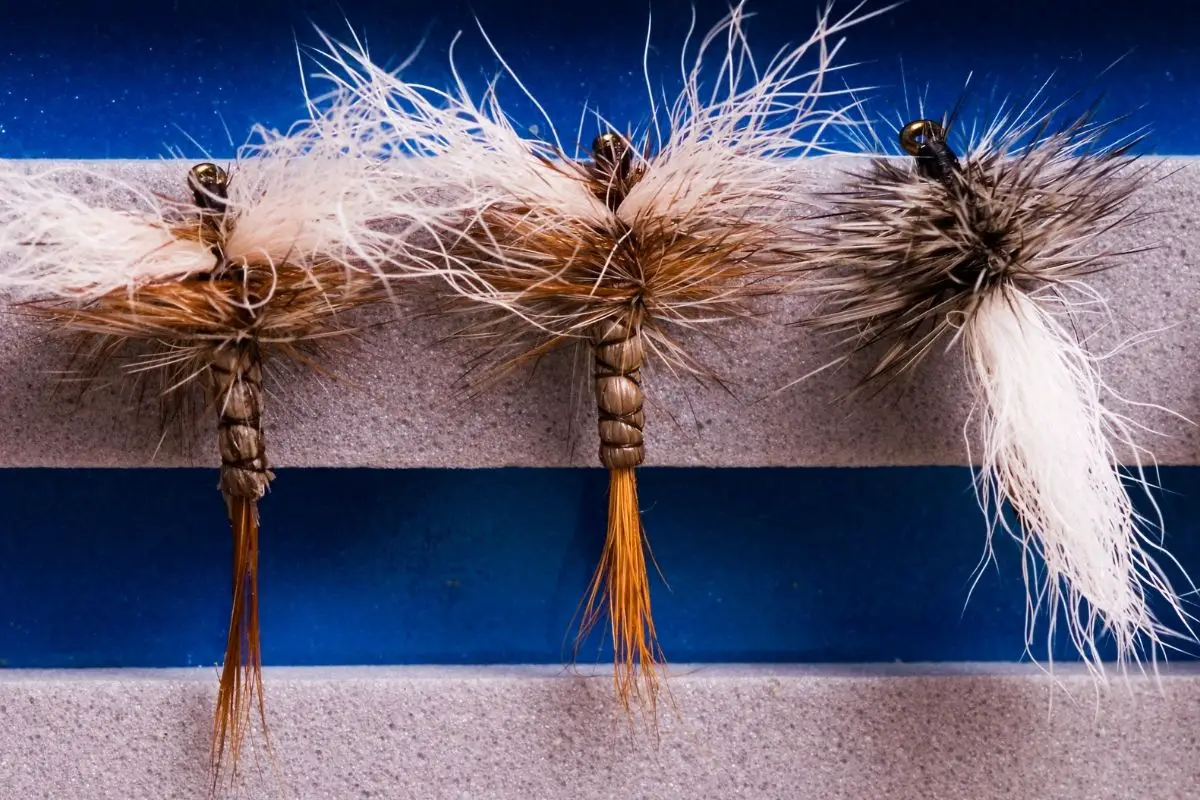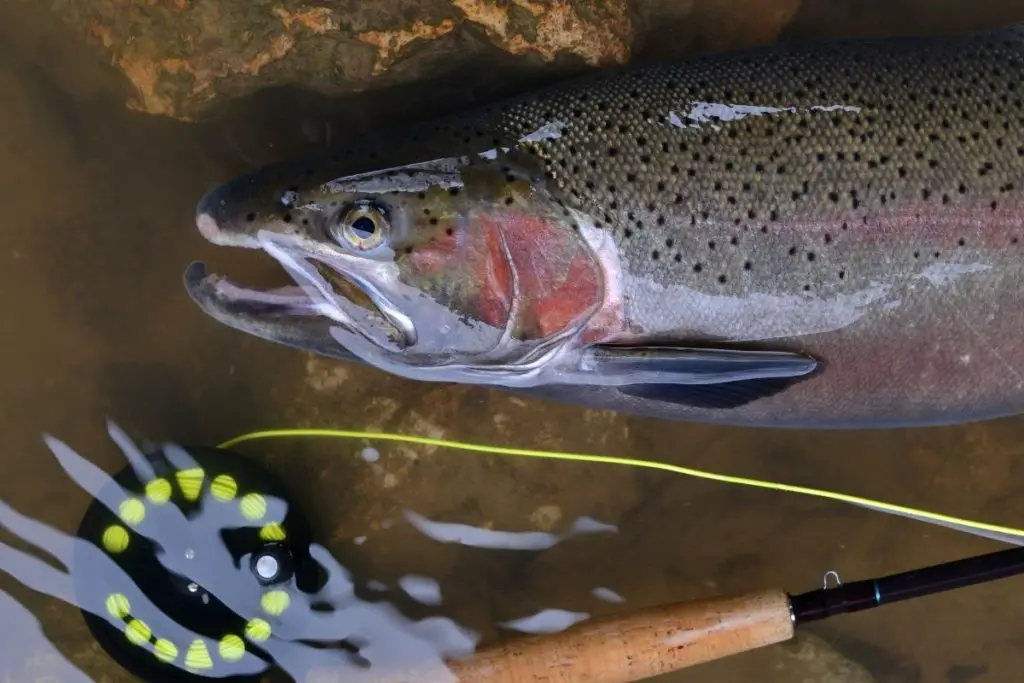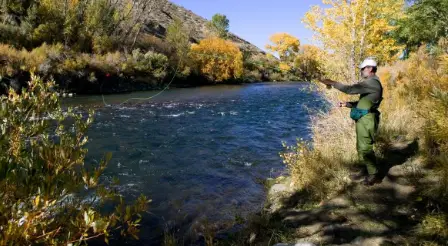Fly-fishing is a great way to catch trout. The method can be known as a sport where you cast a line with a fly attached to it into a river or lake. The fly is designed to attract fish such as trout, and once they bite, you reel them in via a rod. This may mean several hours spent in a cold river but it can be worth it.
To fly fish for trout you can use the two main types of flies: wet flies and dry flies. Wet flies are usually tied from natural materials such as feathers, fur, hair, and silk. Dry flies are typically made from plastic, metal, or other man-made materials.
There are many tricks to catch trout effectively and it can be a case of finding the ideal spot or simply having the right gear with you. Trout can be difficult to catch so be patient and always be prepared to try something new. Try not to feel rushed and you can learn how to fly fish for trout.
The Fly
There are different kinds of flies that you can try to catch trout. The ones you choose should be close to what trout naturally eat so you should use natural materials including thread and feathers. Dry flies are ideal as they mimic emerging insects which is what trout are known to consume and a floating fly can move along with the current.
Wet flies can be fished below the water’s surface and tend to mimic pupal-esque insects. Then there are streamers which are larger, almost fluffy-looking flies that, once wet, look like those flies that swim in the water.
Fly-fishing can seem quite overwhelming at first so practice with various flies before you are comfortable with a particular one or one seems more successful.
The sport is meant to be enjoyed and part of that is the learning process. From finding the right gear to the right spots and the right technique, a lot of that technique can be learning how to use the right fly effectively.
Read The River
Experienced anglers should know how to read a river and that may come after a large time spent on the water. If you prefer a particular section of the river then examine its seams, pools, and riffles so you know where to look.
A lot of inexperienced anglers fail to appreciate the different sections of a river and do not put much thought into where they cast. While you should set out a few hours for fly-fishing, if you waste it in the wrong spot then you are only going to get frustrated.
Look for the areas where whitewater develops, notably in shallow and rocky areas. These are ideal hiding spots for trout as they lurk for passing food.
You could also try a run that comes before a riffle as this is where the water can slow down and become noticeably deeper, which is another good hiding place. Here you may find the trout along the edge as they assume aquatic insects including mayflies and stoneflies which will be making their way downstream.
Try A Seam Or Pool
You may want to try an area where two currents meet which is known as a seam. This is an ideal place to cast as trout will wait in a seam as it forms a feeding lane for food to come their way. In places where the current flows relatively fast, there could be several trout waiting to be caught.
Where your fly sits in the moving water is important as the trout has less time to work out if your fly is any better than the natural ones. While they may be more inclined to bite, you have to be quick to hook them and reel them in.
Another good place to cast is a pool as these will be deceptively deep and have the slowest current which can increase your chances of catching a trout. Pools can be tricky though as you need to get your casting as precise as possible, which may not be easy if there are trees overhead. Your line can easily get caught before you have even had a chance to catch a trout.
Get Your Hook Set Properly
Even if you have got the right spot and the ideal cast, that can count for nothing if your hook is not quite right. This also means keeping a focus on your fly, and even your indicator, to ensure that as soon as it goes underwater you are ready to hook that trout.
There is also a balance between managing that slack and getting the timing right in your hook. Forget to manage the slack and the time has already passed for your hook set.
Try to be vigilant by keeping the line in your free hand during the drift so you can control the fly by keeping the tension. Once the trout has gone for the fly, show some patience to ensure it is fully in their mouth and then you can set the hook.
The Right Gear

Tyger Leader is reader-supported and may earn a commission when you book or purchase using our links. Learn more about our affiliate disclaimer here.
There is so much gear involved in fly-fishing for trout that it may all seem too much though most of it is necessary. From waders for standing in the water to the right boots to keep you stable and your feet warm. Then there are the flies themselves, the rods, reels, and leaders.
If there were specific pieces of equipment to concentrate on then try to get a trout reel and rod that you can trust. You should not look to go for the most expensive gear yet a decent graphite rod and reel should be high up on your shopping list.
The line is important too as it should consist of the backing, a fly line than the leader, and the tippet. Try to find the right-sized tippet as trout can be quite picky, plus you do not want to make it too heavy or visible. The lines can also prove to be an issue as trout can be known to avoid visible lines once they are spotted in the water.
Part of the trick in fly-fishing is to present the bait effectively. That means showing the fly but ensuring that the trout cannot sense that there is a line attached to it. This is why your leader and tippet are so crucial.
The leader needs to ensure that the more weight fly line does not slap the water which may scare the trout. It should be nearly invisible between the tippet and the fly itself, even though it is around 9 to 10 feet long.
Cover More Water
It can be quite tempting to think that you have found a particularly productive spot. You have done your research on the area and decided that you are going to catch some trout. Even after an hour, you are still keeping the faith yet it should be time to move on.
Experienced anglers will tell you that covering the water is an ideal way of ensuring that you get a bite. Perhaps simply moving ten feet every hour can be an effective way of covering a particular stretch of a river. That may mean having to spend time reading the river yet it should prove effective.
Top Tips Catch Trout using a fly rod
One common mistake when fly-fishing for trout is persisting with the same single fly pattern. One that worked previously may not work the next time to liven it up a bit.
Try your best to match the hatch, whether that be a live dry-fly hatch or trying to mimic baitfish by going for streamers. You should always try to go for natural patterns and imitations.
Do not get too disappointed if you cannot get a bite. Be prompt when it comes to deciding when to change tactics. You can try to change the pattern, even the color to a brighter one. This could be after an hour of little to any action with your fly so you can go bold with a fly you may not have tried before.
Final Thoughts
Trout tend to prefer cold water so try to avoid the middle of summer as the water may get too warm for them. Moving water tends to be a good place to catch trout, especially rivers and it can be quite a meditating experience wading some trout in a running river.
If you prefer to be social then bring a friend along and you can exchange tips or maybe turn it into a competition.
Simply having someone around to talk to and endure if it feels like a particularly long day can make it an enjoyable experience.
Fly-fishing can be time-consuming and extremely challenging, especially when trying to catch a trout. However, there is so much to learn that you need to dedicate hours and days until you can be truly confident that you have found a method that works. Take your time, learn some skills, and improve your casting technique which should help you catch some trout.



